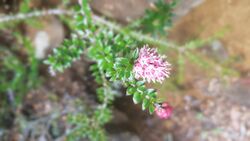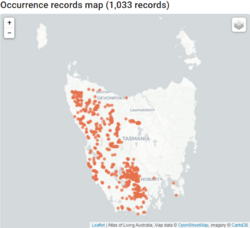Biology:Trochocarpa cunninghamii
| Trochocarpa cunninghamii | |
|---|---|

| |
| Trochocarpa cunninghamii in bloom on Tarn Shelf Track, Mt Field National Park, Tasmania February 2020 | |
| Scientific classification | |
| Kingdom: | Plantae |
| Clade: | Tracheophytes |
| Clade: | Angiosperms |
| Clade: | Eudicots |
| Clade: | Asterids |
| Order: | Ericales |
| Family: | Ericaceae |
| Genus: | Trochocarpa |
| Species: | T. cunninghamii
|
| Binomial name | |
| Trochocarpa cunninghamii | |

| |
| Occurrence records from Atlas of Living Australia[3] | |
| Synonyms[4] | |
| |
Trochocarpa cunninghamii is a flowering plant species of the family Ericaceae. It is commonly referred to as straggling purpleberry due to its round flattened mauve drupe fruits.[5] This woody shrub is usually found in the understorey of rainforests and subalpine forests in the Central Plateau and western Tasmania, and is endemic to Tasmania.[5]
Description
T. cunninghamii is a low scrambling prostrate shrub with reddish new growth.[6][5] Leaves are 5-10mm long (with 5-7 veins visible from the underside of the leaf) at alternate at right angles to the stem, with a dark green adaxial (upper) surface and a lighter abaxial (lower) surface.[7][5] In summer, pink and white tubular flowers bloom and have dangling spikes near the end of branches.[5] The purplish blue-black fruit is present year-round and is described as round flattened mauve drupes about 1 cm in diameter.[6][5][8]
The foliage of this species can be mistaken for Trochocarpa gunnii as it has a similar appearance.[7] T. cunninghamii can be easily distinguished from T. gunnii by its growth habit; T. gunnii is a larger (3–6 metres high, 2–3 metres wide) erect dense to open shrub to small tree, whereas T. cunninghamii has a low scrambling habit (0.2-1.5 metres high, 0.5–2 metres wide).[5] T. cunninghamii is more commonly found at high altitudes than T. gunnii.[7] Trochocarpa disticha also closely resembles T. cunninghamii, however T. disticha is a large shrub with larger leaves, restricted to far southeast Tasmania and regarded as uncommon.[7]
Distinguishing features
- Conspicuous reddish new growth
- Leaves at right angles to the stem
- 5-7 veins visible from the underside of the leaf
- Scrambling (prostrate) shrub
- Understorey plant
- Endemic to Tasmania
Taxonomy
The species was first described by Augustin Pyramus de Candolle in 1839 as Decaspora cunninghami,[1][9] and in 1963 was transferred to the genus, Trochocarpa, by Winifred Curtis.[1][2] The Council of Heads of Australasian Herbaria accepts this name.[1] However, Plants of the World online considers Trochocarpa cunninghamii to be a synonym of Trochocarpa disticha Spreng.[10]
Etymology
The genus name, Trochocarpa, is derived from Greek; trochos (wheel) and carpos (fruit).[11] This is attributed to the separation of the fruit which is arranged into "ten single-seeded stones", likened to spokes on a wheel.[11]
The species name, cunninghamii, honours English botanist Allan Cunningham, who circumnavigated Australia between 1816 and 1839 to collect plants[12][13].
Habitat and Distribution
T. cunninghamii is found only in subalpine forests and rainforest in Tasmania.[5][3] It is commonly found in the understorey layer of forests in the Central Plateau and western Tasmania.[5] T. cunninghamii can also sometimes be found in alpine woodland and rocky habitats at high altitudes.[6] Almost all recorded sightings are restricted to the western half of Tasmania.[3]
References
- ↑ 1.0 1.1 1.2 1.3 "Trochocarpa cunninghamii". Australian Plant Name Index (APNI), IBIS database. Centre for Plant Biodiversity Research, Australian Government. https://biodiversity.org.au/nsl/services/rest/name/apni/.
- ↑ 2.0 2.1 Curtis, W.M. (1963), Angiospermae: Lythraceae to Epacridaceae. The Student's Flora of Tasmania 2: 431, 463
- ↑ 3.0 3.1 3.2 "Trochocarpa cunninghamii" (in en-AU). Atlas of Living Australia. https://bie.ala.org.au/species/https://id.biodiversity.org.au/node/apni/2886442.
- ↑ Trochocarpa cunninghamii (DC.) W.M.Curtis in GBIF Secretariat (2019). GBIF Backbone Taxonomy. Checklist dataset doi:10.15468/39omei accessed via https://www.gbif.org/species/4010639 on 2020-02-24.
- ↑ 5.0 5.1 5.2 5.3 5.4 5.5 5.6 5.7 5.8 Howells, Christine (2012). Tasmania's natural flora. (Second ed.). Hobart, Tasmania. ISBN 978-0-909830-66-3. OCLC 803605684.
- ↑ 6.0 6.1 6.2 "Communities". http://www.understorey-network.org.au/communities.html?species=Trochocarpa%20cunninghamii.
- ↑ 7.0 7.1 7.2 7.3 "Key to Tasmanian Dicots". https://www.utas.edu.au/dicotkey/dicotkey/EPACRIDS/sTrochocarpa_cunninghamii.htm.
- ↑ "Trochocarpa cunninghamii" (in en). http://encyclopaedia.alpinegardensociety.net/plants/Trochocarpa/cunninghamii.
- ↑ Candolle, A.P. de (1839). Candolle, A.P. de. ed. "Epacridaceae". Prodromus Systematis Naturalis Regni Vegetabilis 7 (2): 758.
- ↑ "Trochocarpa cunninghamii (DC.) W.M.Curtis | Plants of the World Online | Kew Science". http://powo.science.kew.org/taxon/urn:lsid:ipni.org:names:325985-1.
- ↑ 11.0 11.1 Wapstra, Mark (2010). Tasmanian plant names unravelled. Launceston Tasmania: Fullers Bookshop Pty Ltd. pp. 126. ISBN 9780980472028.
- ↑ "Botanic Gardens and Parks Authority - Crotalaria cunninghamii". https://www.bgpa.wa.gov.au/about-us/conservation/plant-of-the-month/2617-march-2019.
- ↑ "Allan Cunningham (botanist)" (in en), Wikipedia, 2020-01-07, https://en.wikipedia.org/w/index.php?title=Allan_Cunningham_(botanist)&oldid=934521399, retrieved 2020-03-19
Wikidata ☰ Q17248163 entry

